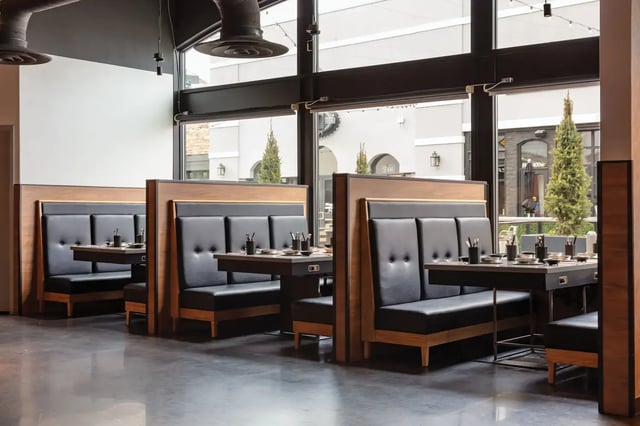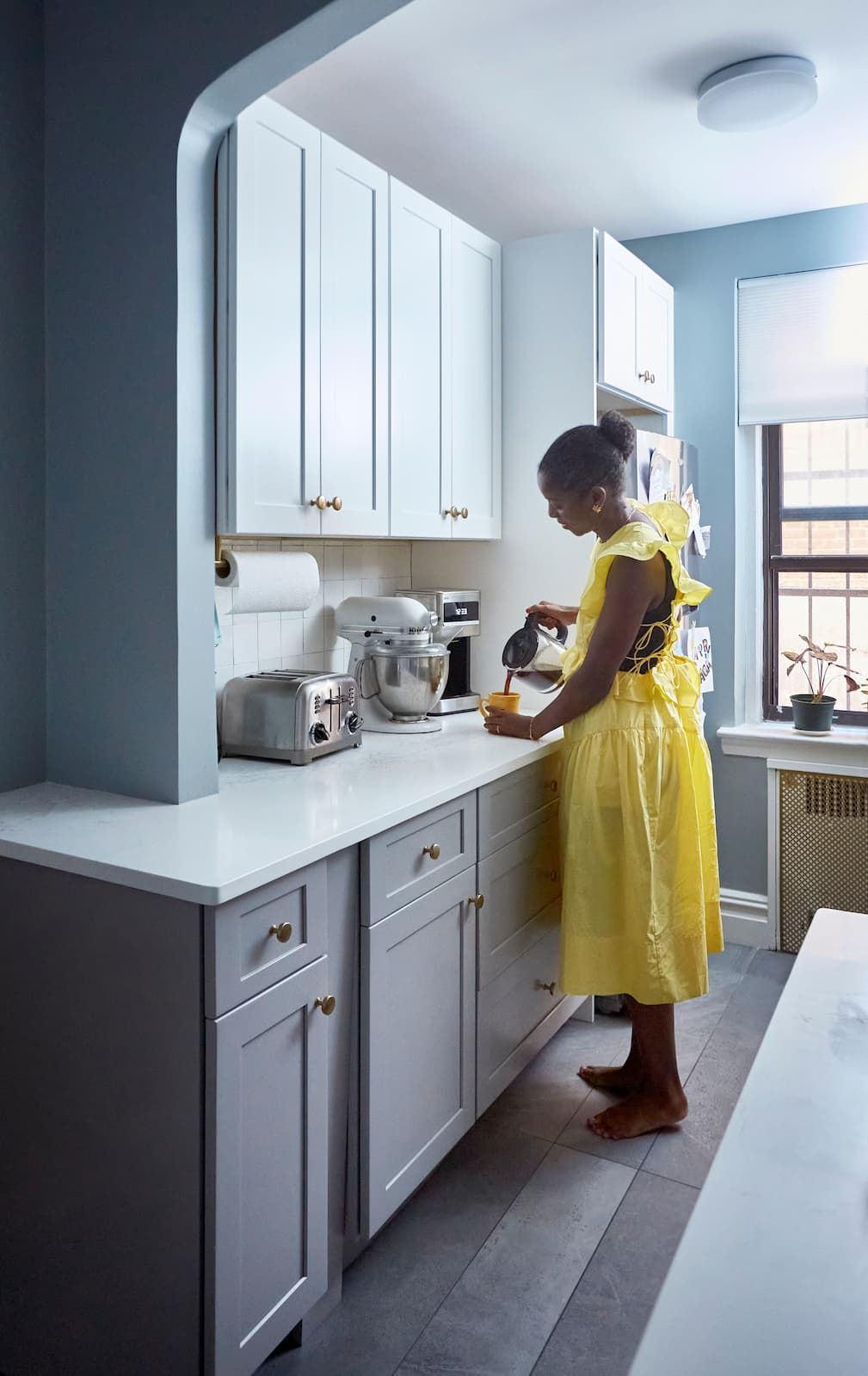
Commercial
Office Bathroom Refurbishment and Design Ideas
12.03.2025


In This Article
A restaurant’s impact is shaped as much by its atmosphere, design, and flow as by the menu it serves. The experience starts before diners ever glimpse the menu: It lives in every line of sight, the comfort of each chair, and how easily the space flows from the front door to the back prep station. In a world where diners have countless options and expectations are high, keeping your restaurant’s space inviting, functional, and aligned with your brand is as important as perfecting every plate. That’s why a thoughtful restaurant remodel isn’t just a cosmetic upgrade—it’s an investment in your reputation, your workflow, and your bottom line.
Block streamlines the entire restaurant renovation process by connecting you with best-in-class contractors who meet rigorous standards in commercial construction and hospitality design. Our matching platform considers your project size, specialty needs, and timeline to ensure you’re paired with professionals who’ve renovated top restaurants, bars, and cafes in your area.
Every pro in our network is thoroughly vetted for craftsmanship and reliability, and you’ll have a dedicated Project Planner guiding you from proposal to permitting to punch list. With Block, you don’t lose valuable weeks to searching and guesswork—you gain a trusted partner who accelerates your remodel and ensures it’s built to last.
Every successful restaurant remodeling project starts with clever planning and acute attention to detail. Use this checklist to guide your decisions and deliver not just a refreshed space, but an elevated experience for your guests and your team.
Designing an efficient, comfortable dining room is both an art and a science. The distance between tables plays a significant role: fine dining establishments can often succeed with about 18 inches of space between the backs of chairs, giving just enough privacy and elegance. More casual spots or high-turnover cafes can make do with as little as 11 inches—though you’ll want to observe your own clientele to ensure this feels right.
Rethinking your current layout can reveal opportunities to add seats, improve traffic flow, or foster more intimate nooks without crowding the space. For example, you might discover that shifting a banquette or adjusting table sizes enables four extra covers per night or that opening up a previously blocked sightline suddenly elevates the atmosphere across the entire dining room.

The layout behind the scenes is every bit as critical as the dining area. Congested prep stations, awkward dishwashing routes, or walk-ins that sit half-empty are signs your flow could be vastly improved with an intentional restaurant remodel. Bringing your kitchen team into the planning process is invaluable—a simple walk-through to pinpoint pain points often uncovers opportunities to streamline.
Sketching both your current and potential “back of house” layouts can reveal solutions like consolidating prep areas, adding pass-through windows, or reconfiguring storage for faster restocking. Thoughtful spatial design means fewer steps, less confusion, and ultimately, higher productivity (and morale) during even the busiest shifts.
Your restaurant should feel unmistakably “you” at first glance. Pinpoint what sets your brand apart, whether that’s rustic warmth, understated modernity, or playful energy—then share this north star with both your contractor and any design professionals involved. Clearly expressing your vision helps align everyone, from the flooring supplier to the muralist, so cosmetic choices reinforce your signature vibe.
Your brand should also play a role in material selection, ensuring your investment enhances (rather than dilutes) your identity. A restaurant’s story is told through materials, colors, lighting, and even the smallest decor elements; make them cohesive, and your remodel will stand the test of time.

It’s vital to understand the condition of your space before deciding between a refurbishment or a complete overhaul. Examine for any signs of uneven floors, worn finishes, outdated lighting or signage, and especially unseen issues—like water damage behind walls or outdated wiring.
Documenting what’s in good shape—and what urgently needs repair—lets you prioritize investments and potentially save on costs by retaining salvageable features. For example, original tin ceilings or hardwood floors can be refinished rather than replaced for an impactful but budget-friendly refresh. Knowing your starting point also makes it easier to communicate needs to contractors and accurately scope the restaurant remodeling costs.
Your restaurant’s curb appeal can set a tone before guests even walk through the door. Fresh paint, updated signage, and well-lit pathways send a message of care and professionalism, while tattered furniture or faded awnings invite doubt. The entry area should feel intentional and inviting, with accessible ramps or clear walkways where needed. Consider adding planters, seasonal touches, or branded window graphics to create a sense of arrival. In the age of online reviews and social media, your facade isn’t just for walk-ins—it’s part of your digital marketing too.
The restaurant renovation cost can range widely—from $100 to $300 per square foot as a general guideline—but requires a tailored look at your concept, market, and desired impact. Factor in not just the upfront construction and finishes, but also equipment upgrades, permits, design fees, and a contingency fund for the unexpected.
Financing options to consider include SBA loans, lines of credit, equipment leasing, or partnering with local investors. Don’t forget to budget for lost revenue if closing during construction, as well as reopening marketing to get guests back in the door. The most successful projects tie each spending decision to the guest experience and long-term operational needs.
Strategic planning can reduce disruptions and even speed your return on investment. Aim to schedule major work during your slowest season when possible, and use the lead-up time to communicate with staff and guests about what’s coming. For modest restaurant refurbishments or cosmetic updates, a turnaround of four to six weeks may be realistic, while a full-scale restaurant renovation or bar renovation could require several months. Build extra time into the schedule for permit approvals, inspections, and equipment lead times—these almost always take longer than anticipated. Above all, transparency and flexibility with your team will help everyone adapt as the project progresses.
The case for closing: Shutting your doors during a major restaurant remodel allows for faster, less complicated construction. It also minimizes risk for food safety or operational hiccups. Above all else though, it prevents dust, noise, and unsightly views from leaving a bad impression on guests, leading to lost future business.
The case for staying open: Smaller updates can often be scheduled during off-hours, with sections of the dining room or kitchen rotated out of service as work progresses. This approach requires careful coordination (and isn’t right for every project), but it allows you to maintain cash flow, keep your team active, and stay connected to regulars.
Regulatory compliance is a cornerstone of every successful restaurant renovation. Expect city and state inspections for fire safety, health code, ventilation, ADA accessibility, and egress lighting. Permits may be needed for everything from signage changes to kitchen hood upgrades and restrooms.
Choosing a contractor who understands your local regulations reduces risk and keeps your timeline on track—mistakes here can result in costly delays, forced closures, or even rework.
Remodeling a restaurant is one of the most high-stakes projects you can take on as an owner or operator—and the quality of your partners can make all the difference. Block’s rigorous vetting and contractor-matching process means you work only with commercial renovation experts who’ve mastered the complexity of restaurant and bar remodels. From realistic budgeting and timeline management to code compliance and creative solutions, your project gets the guidance it needs at every turn. When you remodel with Block, you’re not just refreshing a space—you’re investing in your restaurant’s next chapter of growth and success.

Written by Block Renovation

Renovate confidently with Block
Easily compare quotes from top quality contractors, and get peace of mind with warranty & price protections.
Thousands of homeowners have renovated with Block

4.5 Stars (100+)

4.7 Stars (100+)

4.5 Stars (75+)

Commercial
Office Bathroom Refurbishment and Design Ideas
12.03.2025

Commercial
Grocery Store Renovation Checklist & Expert Remodel Ideas
11.22.2025

Commercial
Convenience Store Design: Interiors & Exteriors
11.22.2025

Commercial
Fit Out Contractors - Finding & Vetting Specialists
11.22.2025

New York
NYC Office Renovations: Contractors & Remodeling Tips
11.14.2025
Renovate confidently